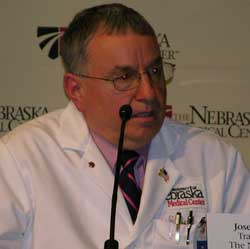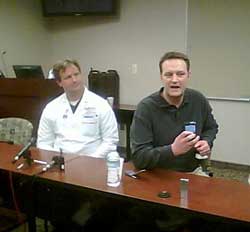 |
Joe Stothert, M.D., Ph.D., addresses the media on Thursday about the surgical efforts made to save the life of shooting victim Fred Wilson. |
 |
Shooting victim Jeff Schaffart displays the Blackberry device he used to let friends know he was ok while riding in an ambulance to The Nebraska Medical Center. Robert Muelleman, M.D., chairman of the UNMC Department of Emergency Medicine and chief of The Nebraska Medical Center’s Emergency Department, looks on. |
From treating victims of the shooting spree, to providing counseling and emotional support for those in the mall when the rampage occurred, to speaking to the media about how a community can cope with such tragedy, medical center personnel were using their expertise and making a large impact during these dire moments.
“Our thoughts and prayers turn to those who are suffering as a result of Wednesday’s tragedy,” said UNMC Chancellor Harold M. Maurer, M.D. “Our employees were at their best and provided a shining light of hope and stability for the community during this dark time.
“Their efforts immediately following this tragedy made me proud. I know they will continue to provide excellent service to the community as we confront the lingering effects of this horrible event.”
Several of the victims were brought to UNMC’s hospital partner, The Nebraska Medical Center, including 61-year-old Fred Wilson, a customer service manager at the Von Maur store where the shooting spree occurred.
Wilson was shot in the left shoulder by the gunman, 19-year-old Robert Hawkins of Bellevue. The bullet exited Wilson’s body through his chest, leaving a gaping hole and causing him to loose a large amount of blood.
Joe Stothert, M.D., Ph.D., professor of surgery at UNMC and a surgeon at The Nebraska Medical Center, operated on Wilson, a former English teacher at St. Albert Catholic Schools in Council Bluffs, Iowa.
Following surgery on Wednesday evening, Wilson’s condition was upgraded from critical to serious.
Jeff Schaffart, 34, an attorney at an Omaha law firm, also was treated at The Nebraska Medical Center for gunshot wounds to his left upper arm and index finger. Schaffert was with his wife shopping for a dress his 2-year-old daughter could wear to visit Santa later in the evening.
|
|
A third victim, a 55-year-old man, was released from the medical center after receiving treatment for injuries on his face he received fleeing from the shooting.
In the hours immediately following the shooting, staff from UNMC’s psychiatry department hit the streets and the airwaves in an attempt to help the community cope with the emotions of the tragedy.
Robin Zagurski, a clinical social worker in the psychiatry department, spent Wednesday evening at a Red Cross triage station at the Hampton Inn motel near the mall talking with people who witnessed or were near the shooting spree – the worst in Nebraska since 1958.
Zagurski said she was on hand to help people prepare for the emotional responses that are common among people who witness and are near such an event.
She told those she visited with that it’s common to experience wide ranging emotions, behaviors and even physical reactions following such events.
“Events such as these leave an even larger number of psychological casualties than they do physical causalities,” Zagurski said. “My goal was to let people know what they can expect in the coming days and weeks in terms of emotions and also to let them know what resources are available to them should they feel the need for help.”
UNMC psychiatrists James Sorrell, M.D., Todd Stull, M.D., and Carl Greiner, M.D., were interviewed by several national and local media outlets about various aspects of the tragedy.
Dr. Sorrell did radio interviews with several local radio and television stations and for the CBS Early Shows on Thursday morning. Dr. Stull talked with Omaha radio station 105.9 FM and CNN Radio in Atlanta and Dr. Greiner talked about risk factors for violence.
All three psychiatrists were interviewed Thursday by The Washington Post and Dr. Stull also was interviewed by The New York Times.
“This was the most intense media experience we’ve had in my 20 years at the medical center,” said Tom O’Connor, senior associate director of UNMC public affairs. “Every national media outlet was calling for patient updates or interviews — not to mention all the local media. The Nebraska Medical Center media relations/marketing team took the lead and did an awesome job, but I was equally proud of the UNMC media relations team for pitching in and helping. The teamwork during this crisis was inspiring.”
Dr. Greiner discussed general observations psychiatrists often make in cases such these. One such observation, Dr. Greiner said, is that people often separate the issues of suicide and homicide, when in fact the two acts are closely related and often intertwined.
People also often misunderstand the role drugs and alcohol play in facilitating such behavior, he said.
“General assessments from forensic psychiatry show that these risk factors are often involved in situations such as this,” Dr. Greiner said. “If you’re a troubled person who doesn’t drink or do drugs, you are much less likely to commit such an act as you would be if you were impaired by drugs and/or alcohol.”
Media reports indicate that Hawkins came from a troubled home, had recently been fired from his job, broken up with his girlfriend and may have had substance-abuse problems.
Drs. Sorrell and Stull said their media interviews have centered on four major issues:
- Why would somebody commit such a crime;
- How should community members respond;
- What should people tell their children; and
- What can be done to prevent such an incident from happening again.
Dr. Stull said the impetus for committing such a crime is very complex.
Dr. Sorrell said that while some people in the community need counseling and psychiatric help to deal with such traumatic events, most will find comfort in simple things — a cup of coffee with a friend, a warm blanket or a good book.
As for discussing the incident with children, parents should be honest about what happened, Dr. Stull said.
“Formulate it in a way that they can understand but be honest about the event and your emotions concerning the situation,” Dr. Stull said. “Children are resilient and can handle the truth.”
Prevention of such incidents is a difficult task, Dr. Sorrell said, noting that in his practice he sees many who suffer from severe depression.
When such incidents occur, however, they highlight elements of society that quite possibly play a role in such behavior including the prevelance of guns and violence in popular culture, Dr. Sorrell said.
Drs. Greiner and Sorrell both said an important part of preventing such behavior is being able to identify the traits of one who is suicidal and how to respond once these signs are observed.
Directly asking people who demonstrate suicidal tendencies if they wish to harm themselves is one option for dealing with such a situation. Other options include informing a person’s loved one of the behavior or even calling the police on the person, Dr. Greiner said.
“I know that sounds extreme but so is suicide,” Dr. Greiner said. “It’s very important that we pay attention to and respect the signs of suicidal behavior. All too often these behaviors are ignored or denied and the results are tragic.”